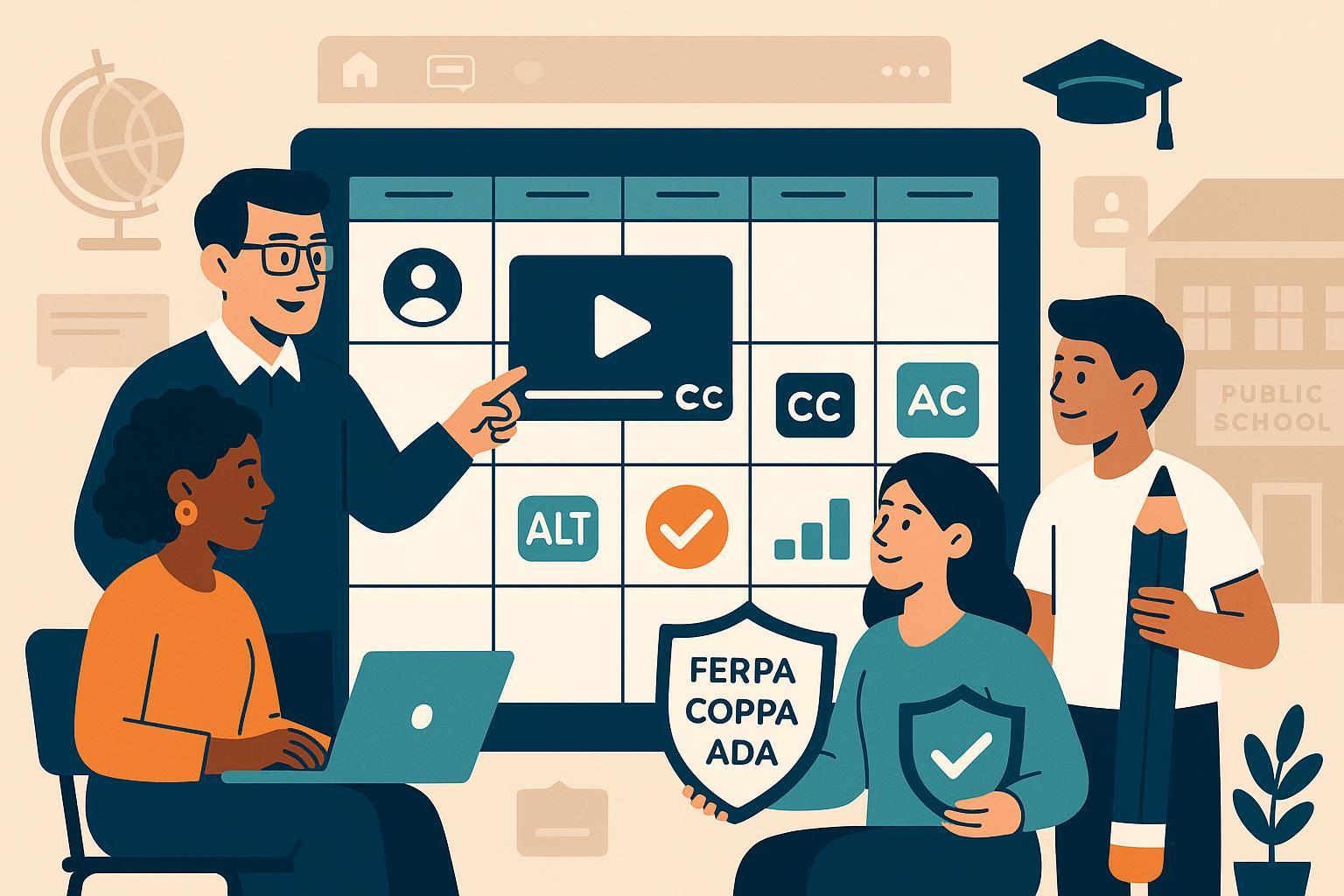Social Media Content Pillars for Education and EdTech (United States, 2025)

If you manage social channels for a U.S. school district, university, or EdTech company in 2025, you’re juggling three pressures every day: prove impact, stay compliant, and keep up with fast-moving formats. Over the past decade, I’ve found that disciplined content pillars—built for education realities—are the most reliable way to align stakeholders, reduce burnout, and ship consistently accessible, high-performing content.
This guide distills what works now in the U.S. Education/EdTech sector, with practical workflows and guardrails you can deploy immediately.
What “content pillars” look like in 2025 (for EDU/EdTech)
Content pillars are the 3–5 themes your social program commits to every week. In 2025, the goal is to align each pillar to an institutional objective and a specific audience persona, then translate it across native formats.
- Map pillars to goals: awareness, recruitment/enrollment, retention/engagement, community trust, thought leadership.
- Build personas: students, parents/families, teachers/faculty, alumni, district/community partners.
- Diversify formats per platform: Reels/Shorts/TikTok, carousels, Stories, LinkedIn docs, YouTube playlists.
- Operationalize the mix: tag posts by pillar, set ratios (e.g., 30% Student Life & Belonging, 25% Teaching & Learning, 20% Family/Community Updates, 15% Accessibility & Equity, 10% Thought Leadership & Innovation), and plan cadence by platform.
Authoritative frameworks back this approach—see the 2025 guidance on pillar strategy from Sprout Social and content planning operational tips from Hootsuite’s planning guide.
Build your K–12 and Higher Ed pillar set
Here’s a sector-specific starting point. Adjust ratios by audience and goals.
-
Student Life & Belonging
- K–12: classroom spotlights, club highlights, sports recaps, SEL prompts. Consider linking to sector perspectives like eSchoolNews’ SEL curriculum highlight (2025).
- Higher Ed: day-in-the-life Reels, residence hall tours, student org takeovers.
-
Teaching & Learning (microlearning clips)
- 30–90 second concept explainers, lab demos, “assignment walkthroughs,” or faculty tips. Short social videos have been associated with improved short-term academic performance in a 2025 study; see the nonrandomized trial summarized in PMC’s short social video research (2025).
-
Family & Community Updates
- Calendars, policy changes, parent nights, volunteer calls, safety notices; prioritize clarity and accessibility.
-
Accessibility & Equity
- Alt text, captioning, color-contrast adherence, translation where appropriate, and equity spotlights. For accessibility requirements applicable to public schools and universities, review the DOJ’s Title II rule overview in the ADA web and mobile accessibility fact sheet (2024–2025) and practical social guidance from Section508.gov’s social media accessibility page.
-
Thought Leadership & Innovation (AI/VR, digital literacy)
- Showcase ethical AI use, immersive labs, career pathways, and emerging skills. For context on 2025 EdTech directions and AI skills, see eSchoolNews’ 2025 trends overview and their note on prompt engineering as a critical teacher skill (2025).
Compliance-first workflows you can trust
Education social teams cannot afford compliance surprises. Bake checks into your production.
-
FERPA: Protect student PII in education records. Many institutions designate “directory information” (sometimes including photos) and offer annual opt-out; confirm your definitions and track opt-outs. For practical institutional interpretations, see Texas A&M’s guidance on FERPA and student photographs and a registrar’s overview of directory information and opt-outs at VCU.
-
COPPA (updated 2025): If your content or landing pages collect personal data from children under 13, you need verifiable parental consent and strict limits on data use and sharing. The FTC’s Final Rule was published April 22, 2025, with stronger consent and data minimization standards—see the Federal Register’s COPPA Final Rule (2025).
-
ADA/WCAG: Public K–12 and state higher ed must ensure web and app accessibility, including social content. Caption every video, provide alt text for non-decorative images, and meet contrast guidelines (e.g., 4.5:1 for normal text). The DOJ’s Title II rule summary is captured in the ADA web and mobile accessibility fact sheet.
Practical implementation checklist:
- Maintain a standing media release process for non-directory student images/videos; log opt-outs in your CMS.
- For under-13 audiences, disable unnecessary tracking pixels on pages linked from social; document parental consent flows.
- Build an accessibility QA step in your content calendar: alt text, captions/transcripts, contrast, keyboard operability.
From strategy to execution: pillar tagging, cadence, and approvals
Operationalize pillars so they persist beyond one enthusiastic manager.
- Tag every post by pillar in your scheduler; enforce weekly mix ratios. Many teams use 3–5 pillars and review monthly to rebalance—an approach echoed in Sprout Social’s 2025 pillar guidance.
- Define cadence by platform. Use audience data to prioritize: U.S. adults gravitate to YouTube (83%) and Facebook (68%), with Instagram (47%) and TikTok (33%) following, per a January 2024 analysis from the Pew Research Center on Americans’ social media use. For teens, plan more short-form and Stories.
- Establish approvals and a compliance gate. A simple RACI: content owner drafts; accessibility reviewer checks captions/alt text; compliance reviewer confirms FERPA/COPPA alignment; comms lead publishes.
- Standardize templates: pillar brief, post outline, alt-text/caption checklist, and an “evidence note” when referencing impact (link to studies where claims appear).
Advanced 2025 pillar tactics (tested and defensible)
-
AI-driven personalization with ethics
- Publish an AI use statement; ensure transparency and human oversight. EDUCAUSE’s 2025 guidelines summarize core principles you can adopt; see the EDUCAUSE AI Ethical Guidelines (2025).
- Do not use student education records or under-13 data for marketing personalization without explicit, verifiable consent (COPPA/FERPA). Train staff in AI literacy before deploying segmentation.
-
Microlearning and short-form series
- Convert complex topics into 30–90 second clips with strong captions, series titles, and end-card CTAs to longer resources. A 2025 study associates short social video supplements with improved short-term academic performance; review the findings in PMC’s short social video study.
-
VR/AR storytelling with accessibility
- Tease simulations or labs via short 360 or over-the-shoulder clips with captions and text summaries. Keep claims conservative and offer alternatives for users who cannot access immersive content. For an evidence-oriented perspective on VR’s learning effects and cautions, see comparative analyses in Frontiers in Virtual Reality (2025).
Measurement that boards and deans respect
Anchor KPIs to sector norms and adapt by pillar.
- Use 2025 education benchmarks to set targets by platform and pillar. Hootsuite’s latest sector benchmarks cite typical engagement ranges for Instagram, LinkedIn, TikTok, and others; see Hootsuite’s education benchmarks (2025).
- Compare against higher ed peers. Rival IQ’s 2024 report provides detailed engagement baselines and case highlights; download the Rival IQ Higher Education Social Media Engagement Report (2024).
- Define per-pillar KPIs: e.g., Student Life on Instagram targets 3.5–4.5% engagement; Thought Leadership on LinkedIn targets ~2–3% engagement; Family/Community updates prioritize reach and link clicks.
- Review monthly; prune pillars that underperform for two consecutive months and scale formats with repeatable ROI.
Real examples to model and adapt
- Higher ed engagement spikes often come from authentic student features and themed carousels. Rival IQ’s 2024 highlights include outsized Instagram performance for campus reels and carousels; see the case snapshots summarized in their higher ed analysis (link above).
- For K–12, lean into family updates, accessibility-first “how to” posts, and student voice within FERPA-safe boundaries. Pair posts with deeper context on 2025 EdTech directions like eSchoolNews’ 2025 trends overview and data protection imperatives in this 2025 wake-up call on privacy and cybersecurity in schools.
Pitfalls to avoid (and the trade-offs behind them)
-
- Risk: posting student PII without consent or opt-out checks; collecting under-13 data without parental consent.
- Fix: directory info audits; media releases; COPPA-compliant consent and data minimization.
-
Accessibility as an afterthought
- Risk: missing captions/alt text; low contrast; inaccessible formats.
- Fix: accessibility QA in the workflow; use Section508 guidance; maintain alt-text standards.
-
Novelty without evidence
- Risk: overhyping AI/VR; eroding trust with unverified claims.
- Fix: cite studies; position innovations as pilots; share learnings and limitations.
-
Burnout and platform sprawl
- Risk: trying to be everywhere without resourcing.
- Fix: prioritize platforms backed by audience data—e.g., 2024 Pew shows adults heavily on YouTube and Facebook, with teens favoring short-form. For youth well-being context, review the 2025 overview of teens, social media, and mental health from the Pew Research Center.
A 4-week, pillar-based calendar you can deploy tomorrow
Week 1
- Student Life & Belonging: day-in-the-life Reel (captions + alt text preview image)
- Teaching & Learning: 60-second concept explainer (series #1)
- Family & Community: month-at-a-glance carousel (high-contrast template)
- Accessibility & Equity: alt-text tips post + translation note
- Thought Leadership & Innovation: AI literacy spotlight with a link to sector trends such as eSchoolNews’ 2025 trends overview
Week 2
- Student Life & Belonging: student org takeover (moderated, FERPA-safe)
- Teaching & Learning: lab demo short (series #2)
- Family & Community: parent FAQ Stories + link to detailed page
- Accessibility & Equity: captioning how-to + contrast checklist
- Thought Leadership & Innovation: VR lab teaser with text summary
Week 3
- Student Life & Belonging: club highlight carousel
- Teaching & Learning: assignment walkthrough short (series #3)
- Family & Community: calendar reminder + safety notice
- Accessibility & Equity: equity spotlight with translation
- Thought Leadership & Innovation: digital literacy mini-quiz
Week 4
- Student Life & Belonging: sports recap Reel
- Teaching & Learning: exam prep microlearning short (series #4)
- Family & Community: volunteer call and event RSVP
- Accessibility & Equity: alt-text and caption audit recap
- Thought Leadership & Innovation: faculty viewpoint on ethical AI; for extended reading, see prompt engineering as a teacher skill (2025)
Close strong: a 2025-ready checklist
- Pillars mapped to goals and personas; weekly ratios set and tagged.
- Accessibility baked in: captions, alt text, contrast, transcripts.
- FERPA/COPPA guardrails operational: releases, opt-outs, consent flows.
- AI/VR treated as pilots with transparent ethics and accessible alternatives.
- KPIs benchmarked to sector norms; monthly reviews and quarterly pruning.
- Crisis-ready: escalation path, templated statements, and documentation.
Education social that earns trust in 2025 is disciplined, accessible, and evidence-based. Build pillars that reflect your mission and community, and iterate with humility and rigor.

